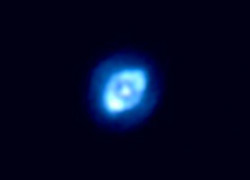 Last week, I blogged about my one-year anniversary. In that article, I began listing my favorite celestial objects in several categories. Following are the categories I didn't get to.
Last week, I blogged about my one-year anniversary. In that article, I began listing my favorite celestial objects in several categories. Following are the categories I didn't get to.
Planetary nebula — The Ghost of Jupiter (NGC 3242) in Hydra. This bright planetary shows lots of detail through 8-inch telescopes, but in large instruments it's amazing. My wife first saw the Ghost through a 20-inch Newtonian reflector at 650x. She turned to me and said, "When can we get a scope like this?" Oh, yeah.
Elliptical galaxy — Leo I in Leo. Because this galaxy lies so close to brilliant Regulus (Alpha Leonis), and because it has a low surface brightness, it's a difficult observation.
Spiral galaxy — The Whale Galaxy (NGC 4631) in Canes Venatici. Through a 16-inch or larger telescope, this galaxy shows lots of non-classical-spiral detail. If you view through an eyepiece that provides a 0.5° field of view, you'll spot the Hockey Stick Galaxy (NGC 4656) southeast of the Whale.
Irregular galaxy — The Cigar Galaxy (M82) in Ursa Major. Back in the early 1980s, I was at Lowell Observatory in Arizona doing spectroscopy for Phillip C. Keenan of Ohio State University. During a free moment (ok, I made the moment free), I turned the 72-inch reflector toward M82. The spectrograph had an eyepiece that yielded a magnification of roughly 2,000x. I'll never forget the sight of the whorls and clouds of that starburst galaxy as I panned across it — panned, because only part of the galaxy fit in the field of view.
Group or cluster of galaxies — The Hercules Galaxy Cluster (Abell 2151) in Hercules. Since I first saw this cluster on a slide taken by the 200-inch Palomar reflector, it's been my favorite object of any type. There, I said it.
Favorite double star — Sirius in Canis Major. Spotting Sirius B, especially through a small telescope, is one of amateur astronomy's great challenges. I made a confirmed observation through my 3.94-inch (100mm) Unitron refractor in December 2001. Notice I didn't label the scope a 4-inch? As far as I know, it's the smallest scope that's ever split Sirius.
Favorite planet — Pluto! Do you hear that, International Astronomical Union?
Favorite sky light — The Gegenschein. You need a dark site to see the Gegenschein, also called the Counterglow. But you also have to look at the right time of year. If the Gegenschein falls within the Milky Way's boundaries, you won't be able to see it. Mid-spring and mid-autumn (Northern Hemisphere seasons) are best.
Favorite observing site — Williams Ranch, 50 miles east of El Paso, Texas. For my final entry, I'll veer off objects to a place. I've made so many one-time or best observations from this site that I just had to mention it. This location, current dark-sky site of the El Paso Astronomy Club, sits a mile high and has the finest seeing, night to night, I've encountered. Observing here, I avoided the sub-zero temperatures associated with northern Arizona in the winter. Achernar (Alpha Piscis Austrini) rises to a maximum altitude of 0.7° from the Williams Ranch, but I've seen it numerous times.